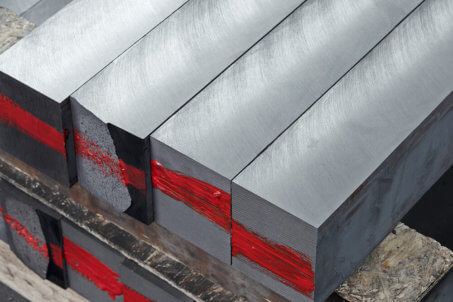Material & Coating Process Compatibility Guide
| Material Description | Common Designation | Typical Application | Typical Hardness | "Coat-ability" PVD CVD TD DCD |
|---|---|---|---|---|
| Air Hardened | A6 | Form Tools, Stamping | 58 - 60 Rc | |
| Air Hardened | A2, A2S | Form Tools, Stamping | 58 - 60 Rc | |
| Oil/Water Hardened | O1, O6, W1 | Draw & Press Tools | 58 - 62 Rc | |
| H-Series | H13, H21, H26 | Hot Work | 52 - 58 Rc | |
| M-Series (HSS & HSCo) | M2, M4, M42 | Cutting Tools | 60 - 65 Rc | |
| Specialty Steel | CPM 3V, 9V, 10V | Stamping & Forming | 59 - 64 Rc | |
| Specialty Steel | Vanadis 4, 10 | Stamping & Forming | 59 - 64 Rc | |
| Specialty Steel | DC-53 | Stamping & Forming | 58 - 62 Rc | |
| T-Series (HSS & HSCo) | T1, T15 | Cutting Tools | 60 - 66 Rc | |
| P-Series | P20 | Molds, General | 25 - 30 Rc | |
| S-Series | S2, S5, S7 | Heading Tools | 56 - 58 Rc | |
| D-Series | D2, D3, D6 | Press & Form Tools | 58 - 62 Rc | |
| Carbide | Tungsten Carbide | Inserts, Dies/Punches | 72 - 82 Rc | |
| Martensitic PH SS | 17-4, 13-8, 15-5, 465 | Molds, Medical, General | 44 - 50 Rc | |
| 400 Series SS | 410, 416, 420, 440 | Molds, General | 40 - 60 Rc | |
| 300 Series SS | 302, 303, 304, 316 | Corrosion Protection | Various | |
| Cold Rolled Steel | 1008, 1010, 1018 | General | 71-110 HRB** | |
| Carbon Steel | 1045, 1065, 12L14 | General | 90-210 HRB** | |
| Alloy Steel | 4140, 4340, 8620, 9310 | Molds, Gears, General | 35 - 45 Rc** | |
| Medium Carbon Steel | NAK 55 | Molds | 35 - 40 Rc** | |
| High Carbon, Low Alloy | 52100 | Bearings | 60 – 63 Rc | |
| Aluminum | 6061 | General Components | Various | |
| Beryllium Copper | moldMAX | Molds, General | 35 - 45 Rc | |
| High Nickel Alloys | Inconel 625 & 718, Invar | Aerospace, General | 80-371 HRB | |
| Titanium | Ti-6AL-4V | Medical, General | xxx | |
| Brass* | xxx | Decorative | xxx | |
| Al/Zn/Mg Castings * | xxx | General Components | xxx | |
| ABS Plastic* | xxx | Decorative | xxx |
* - Can be coated only after being chrome or nickel plated
** - these steels will often be case hardened to increase surface hardness
** - these steels will often be case hardened to increase surface hardness
A very good material for the indicated coating process.
An acceptable material for the indicated process; however, there may be some special process modifications required, such as temperature.
Material can be coated with the indicated process; however, possible material stability or composition issues may result. Not recommended.
This material is absolutely inappropriate for the indicated process: do not attempt.
Please Note the Following:
 This is only a sample listing of materials and should not be considered definitive. Information has been generalized – please contact a Richter Precision Inc. representative regarding your specific application.
This is only a sample listing of materials and should not be considered definitive. Information has been generalized – please contact a Richter Precision Inc. representative regarding your specific application.- All parts, regardless of coating process, should be sent to us already heat treated to your required hardness. In the case of the CVD process, parts will be annealed during coating and then re-heat treated afterward. However, being hardened prior to coating will reduce stresses and distortion during coating
- When considering the PVD process, whenever appropriate for the material, we recommend that final draws be > 800° F in order to ensure that no annealing and/or distortion will occur.
Comparison of Coating Process Characteristics
Process Characteristics | PVDPhysical Vapor Deposition | CVDChemical Vapor Deposition | DCDDynamic Compound Deposition |
|---|---|---|---|
Method | Processed in a vacuum chamber (10-2 to 10-4 Torr) | Processed in atmospheric or vacuum reactor | Processed in a proprietary vessel |
Temperature | Low process temperature (320° to 800° F) | High process temperature (1925°F) | Low process temperature (100° F) |
Deposition Limitations | Line of sight process | Coats wherever gases contact the tool surface | Coats wherever coating media contacts the surface |
Bond Type | Physical | Chemical & metallurgical | Mechanochemical |
Average Thickness | 1-5 µm, or .00004-.0002" | 4-12 µm, or .00016-.00047" | 0.5-2 μm, or .00002"-.00008" |
Material Limitations | Suitable for a wide range of substrates | More limited range of substrates than for PVD | Suitable for a wide range of substrates |
Tolerances | Ideal for closely toleranced components (+/-.0001) | Requires loose tolerances (ex.: +/-.0005 per 1.0" dia.) | Ideal for closely toleranced components (+/-.0001) |
Post-Processing | No heat-treating required after coating | Heat-treating required on steel parts | No heat-treating required after coating |
Edge Build-Up | No excessive coating build-up | Requires hone on edges due to thicker coating | No excessive coating build-up |
Surface Finish | Coating generally replicates existing surface finish | Post-coating polish can achieve good finishes | Coating may have slight matte effect |


